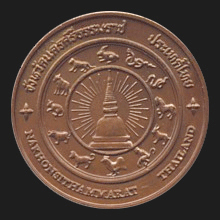|
Nakhon Sri Thammarat (นครศรีธรรมราช)
The provincial capital of a province (map)
of the same name in South Thailand, 780 kms
South of
Bangkok. It has a population of approximately 72,000 with a large
Muslim community.
Centuries before the
Srivijaya empire spread over the southern peninsula there was a
city state
with the name Ligor (Lagor) which was the capital of the then Trambralinga
empire.
Later on, when monks from
Sri Lanka founded a monastery there, the name was
changed into Sri
Dhamma
Raja,
Pali-Sanskrit for ‘City of the Holy Dhamma King’, what eventually became the present Thai name. The area
around
Nakhon Sri Thammarat was part of
the Srivijaya Kingdom from the 3rd century on, until the rise of
Sukhothai, which incorporated it
into its realm. After the demise of Sukhothai it became one of the
tributary kingdoms of the
Ayutthaya
Kingdom. When in 1767 AD Ayutthaya fell for the second time to the
Burmese, the post of Chao Phraya for Nakhon Sri Thammarat was
vacant. When Luang Sit (หลวงสิท), an
retributive officer of the princely
household, who held the position of deputy governor looking after
the city of Nakhon Sri Thammarat, learned that Ayutthaya had fallen
to the Burmese and that there was no one in charge of the defence of
the country, quickly posed as the new ruler of the city and in 1769
AD, called for its independence. However, King
Taksin, the new Thai ruler, who after the destruction of
Ayutthaya had relocated the Thai capital to
Thonburi,
sent in his troops to quell
the insurgency and arrested Luang Sit, who he replaced with
his own grandson
Chao Nara Suriyawong (เจ้านราสุริยวงศ์), sent in from the new capital.
After this prince died, King Taksin in 1776 AD announced a decree
that future rulers of Nakhon Sri Thammarat would have to be loyal to
the throne and prove their allegiance by allowing their progeny to
serve at the royal court in the capital as an assurance during their
time in office. This rule was later annulled by his successor, King
Rama I, who in 1784 AD appointed Phat (พัฒน์), his own
viceroy and son-in-law, to rule the province,
though granting him the title of only Chao Phraya, as had been
customary during the Ayutthaya Period. Thus, Nakhon Sri Thammarat
was once ruled by a monarch, having royal dominion
for about eight years. Chao Phraya
Phat governed until the reign of
Rama II and at an old age retired
to the honorary post of Counselor, allowing his son Phra Borirak
Phoobet (พระบริรักษ์ภูเบศร์), who
allegedly was an illegitimate son
of the ruler of Thonburi, to become the new ruler of Nakhon Sri Thammarat.
With later administrative reforms, the former tributary kingdom was
more closely integrated into the Thai state and in 1896 the
Monthon
Nakhon Sri Thammarat was established, consisting
of the provinces Nakhon Sri Thammarat,
Songkhla and
Pattalung. With the abolishment of
the monthon system in 1932, the province covering only the central
parts of the former kingdom became the top-level administrative
subdivision of Thailand. During
the early development of the many different Thai kingdoms the city
of Nakhon Sri Thammarat was an
important centre for religion and culture, and it is today
still known for the production of
nielloware
(fig.),
ya lipao
(fig.),
nang thalung (fig.) and dance masks. Places of interest include
Wat Mahathat Wora Maha Wihaan
(map
- fig.) with its
56
meters high chedi with a spire plated in pure gold. The city is situated in a
province of the same name which also includes the 570 kms² large Khao Luang
National Park, pristine beaches on its North coast, and shadow
puppet theatres. The most important resources of the region are
rubber, coffee, rice and fruit. Nakhon Sri Thammarat is also famous for its bull
fighting sport, called
kilah chon hua
in Thai. This province has 21
amphur and 2
king amphur.
See also
Nakhon Sri Thammarat data file. 回






|

